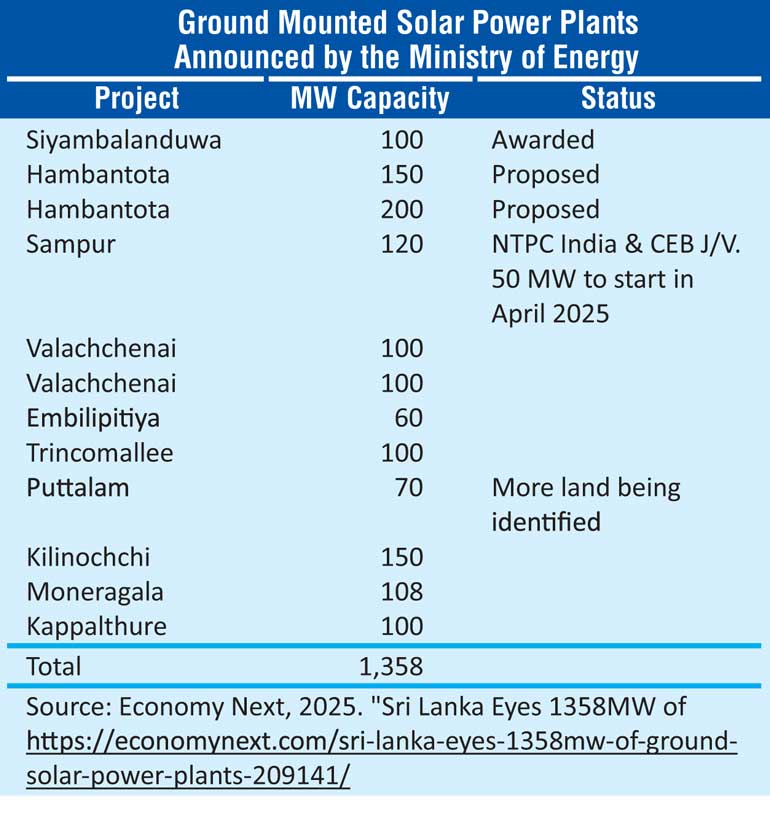Wednesday, 9 April 2025 00:22
www.ft.lk
By Anil Cabraal, PhD
King Parakramabahu the Great’s 12th-century decree, “Not even a little water that comes from the rain must flow into the ocean without being made useful to man,” is equally applicable for sunshine and wind today.
 In the Daily FT report of 4 April 2025, renewable energy industry stakeholders highlighted increasing bureaucratic obstacles, inconsistent policies, uncompensated curtailments, lowering solar tariffs and grid inefficiencies hindering renewable energy progress. The article also pointed out governance issues and decisions that undermine existing and new sector investments. They pleaded with the Government to halt this backward slide so that Sri Lanka’s bountiful renewable energy resources and its experienced private sector could be mobilised to benefit the nation.
In the Daily FT report of 4 April 2025, renewable energy industry stakeholders highlighted increasing bureaucratic obstacles, inconsistent policies, uncompensated curtailments, lowering solar tariffs and grid inefficiencies hindering renewable energy progress. The article also pointed out governance issues and decisions that undermine existing and new sector investments. They pleaded with the Government to halt this backward slide so that Sri Lanka’s bountiful renewable energy resources and its experienced private sector could be mobilised to benefit the nation.
Sri Lanka has made good progress with Independent Power Producers (IPP) investing in renewable energy generation (Fig. 1). However, the CEB’s growing resistance to renewables, which is against the national interest, is very concerning. The CEB began uncompensated curtailment of renewable energy generation claiming that it is disrupting the power system, beyond the CEB’s ability to manage it. This article delves into the rationale behind the CEB’s decision and offers recommendations inspired by successful experiences in other countries to maximise renewable energy generation.
CEB’s rationale for curtailment
The CEB blamed the island-wide power outage on 9 February 2025, on an imbalance in the national grid due to excess solar production. However, others blamed incorrect transmission protection settings and operating errors at the Victoria hydropower station. While managing intermittent renewable energy can be challenging, the issues of inadequate infrastructure and poor system control cannot be discounted.
The CEB intends to continue curtailing renewable energy generation without compensation during low demand periods, like Sundays. Additionally, 100 kW and larger solar plants will be shut off during the Sinhala and Tamil New Year period regardless of weather or electricity demand, also without compensation. While this might address immediate grid stability concerns, it has significant consequences for the nation, investors and electricity users. Economic and environmental consequences: Reducing renewable energy production in favour of thermal energy increases fuel imports, straining foreign exchange reserves. Most thermal generation is costlier than renewable energy generation, according to PUCSL data, and leads to increased electricity prices. These impacts harm Sri Lanka’s energy security, the economy, and impede recovery from the financial crisis.
Additionally, replacing renewables with thermal generation raises emissions and jeopardises climate financing and hinders attaining sustainable development goals. It contradicts Sri Lanka’s international commitment to generate 70% of electricity using renewables by 2030.
Investor confidence and policy clarity: Policy uncertainties, and uncompensated curtailments damage investor trust, and discourage future investments.
Grid infrastructure challenges: Curtailing renewables reduces the urgency for the CEB to modernise grid infrastructure and perpetuates technical challenges and inefficiencies.
 Recommendations from global experiences
Recommendations from global experiences
To address challenges and more effectively integrate renewable energy, Sri Lanka can learn from other countries. India and Germany compensate renewable energy producers for output curtailment, especially for “must-run” plants like solar and wind, boosting investor confidence. Germany benefits from its regional interconnection, permitting it to optimally balance electricity supply and demand. Australia uses advanced technologies and substantial energy storage to balance electricity supply and demand; and demand response programs encourage use during peak solar generation periods.
Action plan for Sri Lanka
Sri Lanka needs a modern power grid to integrate renewable energy reliably. A systematic modernisation approach is essential, rather than reactive measures. The Energy Ministry, CEB, PUCSL and SEASL could consider the following to more effectively integrate an increasing share of renewable energy into the power system.
Short-term solutions (0-2 years)
Governance and transparency: Ensure policy consistency, open communication, and maintain accountability to create a stable and predictable investment environment. Additionally, expedite regulatory approvals and offer timely and well-reasoned updates on sector changes to foster trust.
Policy and regulatory support: Adopt forward-looking policies and regulations to prioritise renewable energy and adopt grid stabilising technologies.
Curtailment compensation: Amend the PPA to mandate compensating renewable energy producers during shutdowns or adjust tariffs to account for anticipated curtailments.
Demand response programs: Encourage consumers to shift energy usage to high renewable generation periods through time-of-day tariffs.
Enhancement of grid management: Configure grid protection systems correctly to avoid failures and damage. Improve CEB’s monitoring and control capabilities.
Advanced forecasting tools: Use them to predict renewable energy generation and electricity demand patterns for better electricity dispatch planning.
Medium-term solutions (2-5 years)
Grid modernisation: Invest in smart grids and energy management systems using real-time data, artificial intelligence, and machine learning.
Distributed generation and storage: Aggressively drive growth of roof top solar with battery storage at commercial, industrial and residential facilities. These systems, coupled with demand response programs, will help to significantly enhance grid stability.
Grid-scale energy storage: Use battery energy storage systems to store excess renewable energy and release it during high demand.
Improve grid inertia: Adopt smart inverters, grid forming inverters or synchronous condensers to stabilise grid frequency.
Flexible generation: Invest in technologies like Flexible AC Transmission Systems and Dynamic Line Rating. They can help balance renewable energy variability and improve power transmission efficiency and reliability without necessarily increasing transmission capacity.
Long-term solutions (5 years and more)
Wide area protection networks: These help prevent blackouts by monitoring and responding to disturbances across the power grid in real time.
Large-scale energy storage: Utilise advanced technologies like pumped hydro, green hydrogen, or flow batteries.
Interconnection with India: Establish cross-border grid interconnection to manage renewable energy excess and variability.
Research and development: Sri Lanka universities must revise their curriculum to cover advanced power systems, high renewable energy integration, distributed generation, electricity storage, etc. and partner with the CEB and IPPs in R&D.
 Status today
Status today
The Government and the CEB have started some crisis-response work, but a more strategic, holistic approach is needed. Until recently, the USAID-supported Sri Lanka Energy Program collaborated with the CEB to transition Sri Lanka’s power sector into a market-based, secure, and reliable system, optimising the use of renewable energy. This valuable work must continue with another development partner.
An ADB-funded project seeks to enhance Sri Lanka’s grid through improved transmission, distribution, and protection systems. It will feature the country’s first grid-scale battery storage, a renewable energy forecasting centre, SCADA-linked automation, and better real-time data systems. ADB is also financing CEB and PowerGrid India to assess the feasibility of grid interconnection.
JICA supported feasibility studies for the 600 MW Maha Oya Pumped Hydro Plant. Detailed design is in progress. The estimated cost ranges between $ 800-1,000 million, with construction expected to be completed by 2031. Funding discussions are ongoing with international agencies such as JICA, World Bank, and ADB, but no firm commitments have been made.
The Government has announced 1,358 MW of solar projects and aims to revive the 484 MW Adani Green Energy wind projects. However, promoting these while the CEB curtails such generation sends mixed messages. The CEB must quickly address stability concerns for these projects to proceed.
Conclusion
Sri Lanka’s renewable energy sector has potential to enhance economic growth, sustainability, and energy independence. Making the power grid stable, upgrading regulations, updating infrastructure and knowledge, providing fair compensation, restructuring the electricity industry, and maintaining good governance are crucial steps towards an efficient, lower cost, clean, and resilient energy future.